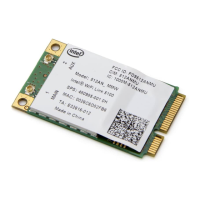Auto Import: Network administrator can export a profile on another computer.
Band Selection: Select the band to use for this connection profile.
Mandatory Access Point: Select to associate the WiFi adapter with a specific access point.
Password Protection: Select to password protect a profile.
Application Auto Launch: Specify a program to be started when a wireless connection is made.
Maintain Connection: Select to remain connected to a user profile after log off.
Back View the prior page in the Profile Wizard.
OK Closes the Profile Wizard and saves the profile.
Cancel Closes the Profile Wizard and cancels any changes made.
Help? Provides the help information for the current page.
Set up Data Encryption and Authentication
In a home WiFi network you can use a variety of simple security procedures to protect your wireless connection.
These include:
Enable Wi-Fi Protected Access (WPA*).
Change your password.
Change the network name (SSID).
Wi-Fi Protected Access (WPA) encryption provides protection for your data on the network. WPA uses an
encryption key called a Pre-Shared Key (PSK) to encrypt data before transmission. Enter the same password in all
of the computers and access point in your home or small business network. Only devices that use the same
encryption key can access the network or decrypt the encrypted data transmitted by other computers. The
password automatically initiates the Temporal Key Integrity Protocol (TKIP) or AES-CCMP protocol for the data
encryption process.
Network Keys
WEP encryption provides two levels of security:
64-bit key (sometimes referred to as 40-bit)
128-bit key (also known as 104-bit)
For improved security, use a 128-bit key. If you use encryption, all wireless devices on your wireless network must
use the same encryption keys.
You can create the key yourself and specify the key length (64-bit or 128-bit) and key index (the location that a
specific key is stored). The greater the key length, the more secure the key. When the length of a key is increased
by one character, the number of possible keys doubles.
Key Length: 64-bit
Pass phrase (64-bit): Enter five (5) alphanumeric characters, 0-9, a-z or A-Z.
Hex key (64-bit): Enter 10 hexadecimal characters, 0-9, A-F.
Key Length: 128-bit
Pass phrase (128-bit): Enter 13 alphanumeric characters, 0-9, a-z or A-Z.
Hex key (128-bit): Enter 26 hexadecimal characters, 0-9, A-F.
With WEP data encryption, wireless station can be configured with up to four keys (the key index values are 1, 2,
3, and 4). When an access point or a wireless station transmits an encrypted message that uses a key stored in a
specific key index, the transmitted message indicates the key index that was used to encrypt the message body.
The receiving access point or wireless station can then retrieve the key that is stored at the key index and use it
to decode the encrypted message body.
Intel® PROSet/Wireless WiFi Connection Utility User's Guide

